ACC00716 - Business Case Studies 2: Financial Feasibility Report, 2019
VerifiedAdded on 2022/11/25
|8
|1438
|446
Report
AI Summary
This report presents a financial analysis of two investment options for DuoLever Limited, a company in the personal care industry. The analysis aims to determine the feasibility of either initiating a new production process or licensing a patented method. The report includes a financial analysis via a spreadsheet and a memorandum addressed to the CEO. The methodology involves cash flow analysis and Net Present Value (NPV) calculations to assess the financial viability of each option, considering inputs like initial investment, sales revenue, operating costs, and tax rates. The findings indicate that the second option, licensing the patented method, is more financially beneficial due to higher annual cash flows and a higher NPV. The report concludes with recommendations, emphasizing the importance of addressing uncertainties related to supplier quality and the need for follow-up measures to ensure product quality. References to relevant literature are also included to support the analysis.
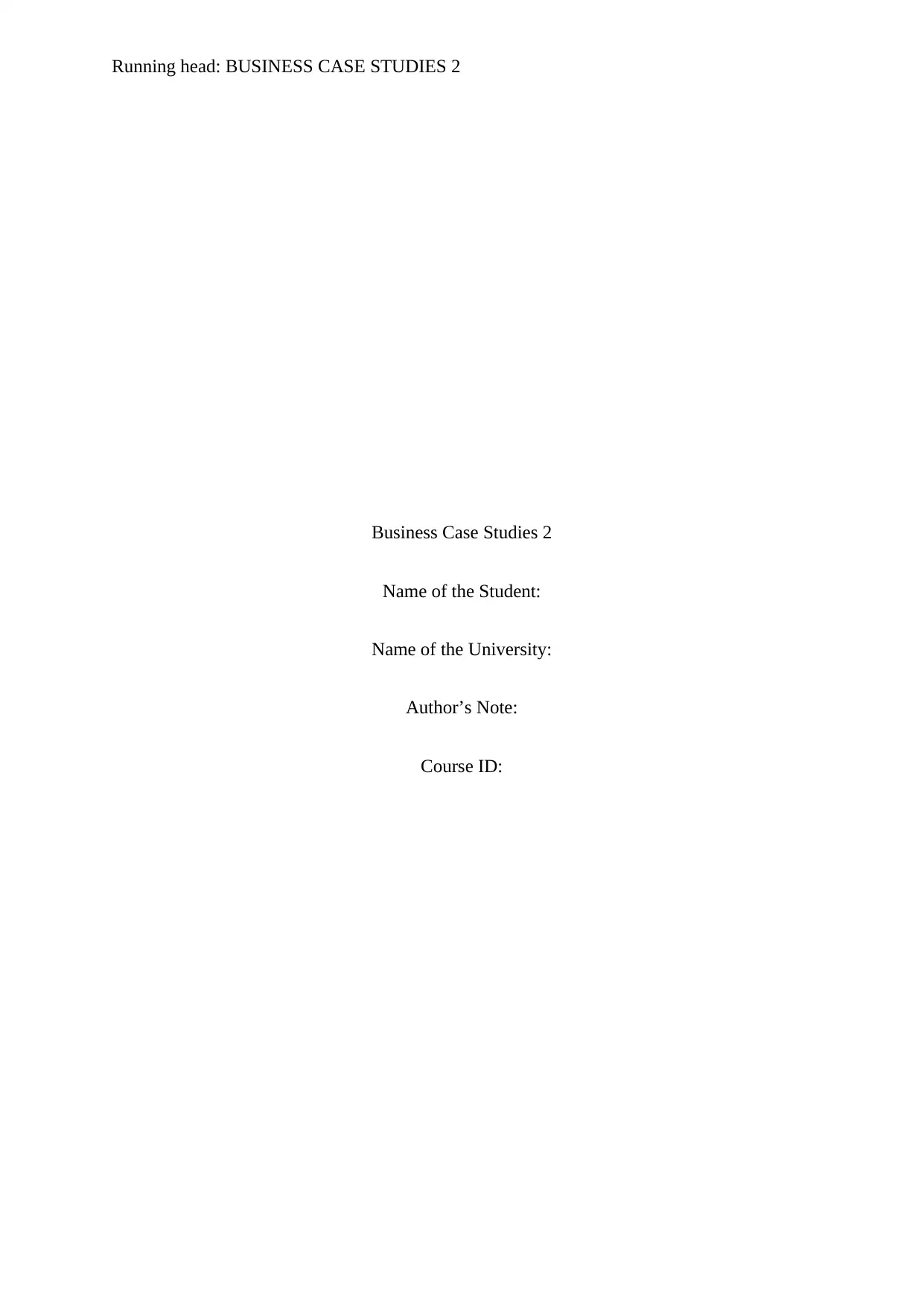
Running head: BUSINESS CASE STUDIES 2
Business Case Studies 2
Name of the Student:
Name of the University:
Author’s Note:
Course ID:
Business Case Studies 2
Name of the Student:
Name of the University:
Author’s Note:
Course ID:
Paraphrase This Document
Need a fresh take? Get an instant paraphrase of this document with our AI Paraphraser
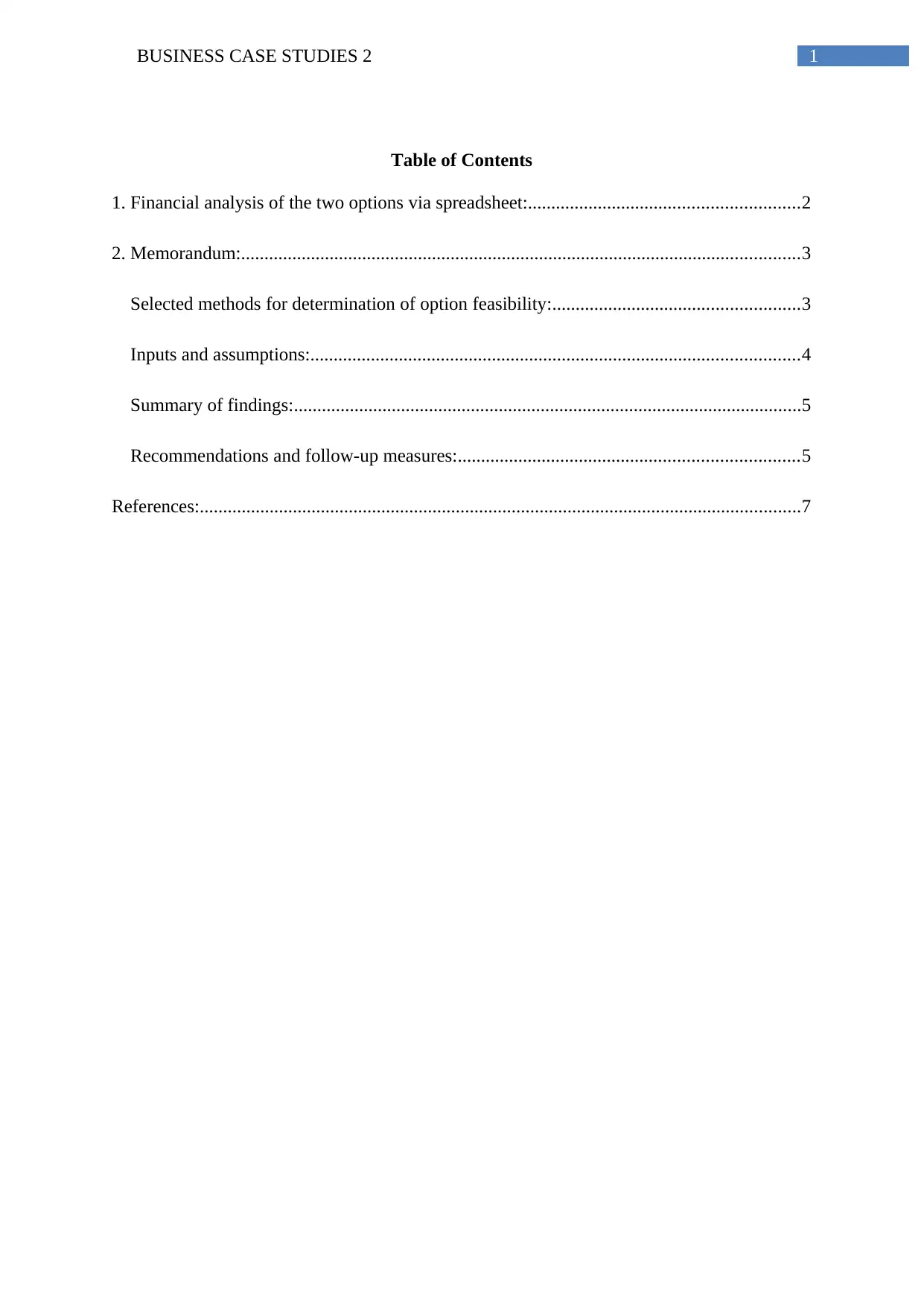
1BUSINESS CASE STUDIES 2
Table of Contents
1. Financial analysis of the two options via spreadsheet:..........................................................2
2. Memorandum:........................................................................................................................3
Selected methods for determination of option feasibility:.....................................................3
Inputs and assumptions:.........................................................................................................4
Summary of findings:.............................................................................................................5
Recommendations and follow-up measures:.........................................................................5
References:.................................................................................................................................7
Table of Contents
1. Financial analysis of the two options via spreadsheet:..........................................................2
2. Memorandum:........................................................................................................................3
Selected methods for determination of option feasibility:.....................................................3
Inputs and assumptions:.........................................................................................................4
Summary of findings:.............................................................................................................5
Recommendations and follow-up measures:.........................................................................5
References:.................................................................................................................................7
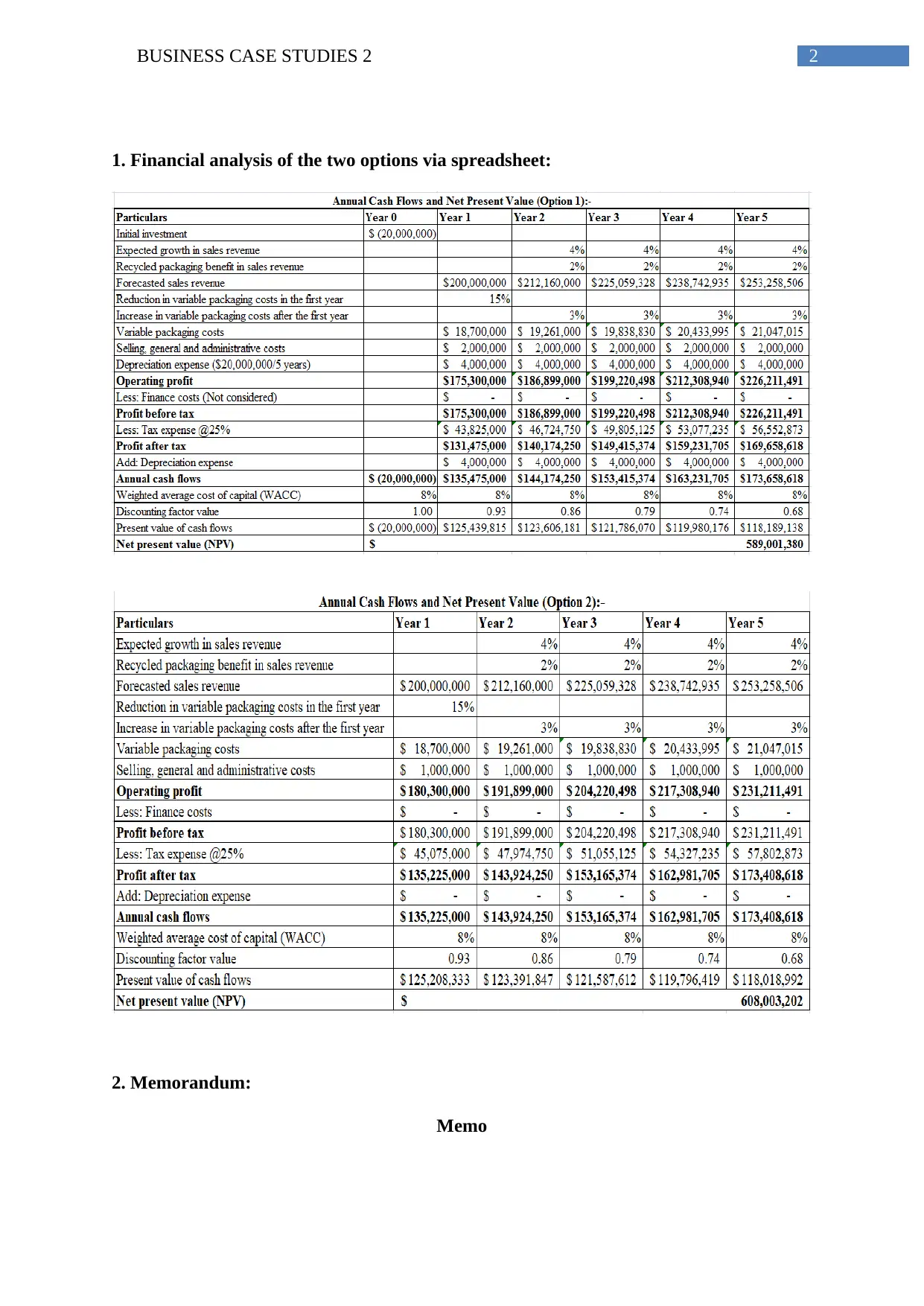
2BUSINESS CASE STUDIES 2
1. Financial analysis of the two options via spreadsheet:
2. Memorandum:
Memo
1. Financial analysis of the two options via spreadsheet:
2. Memorandum:
Memo
⊘ This is a preview!⊘
Do you want full access?
Subscribe today to unlock all pages.

Trusted by 1+ million students worldwide
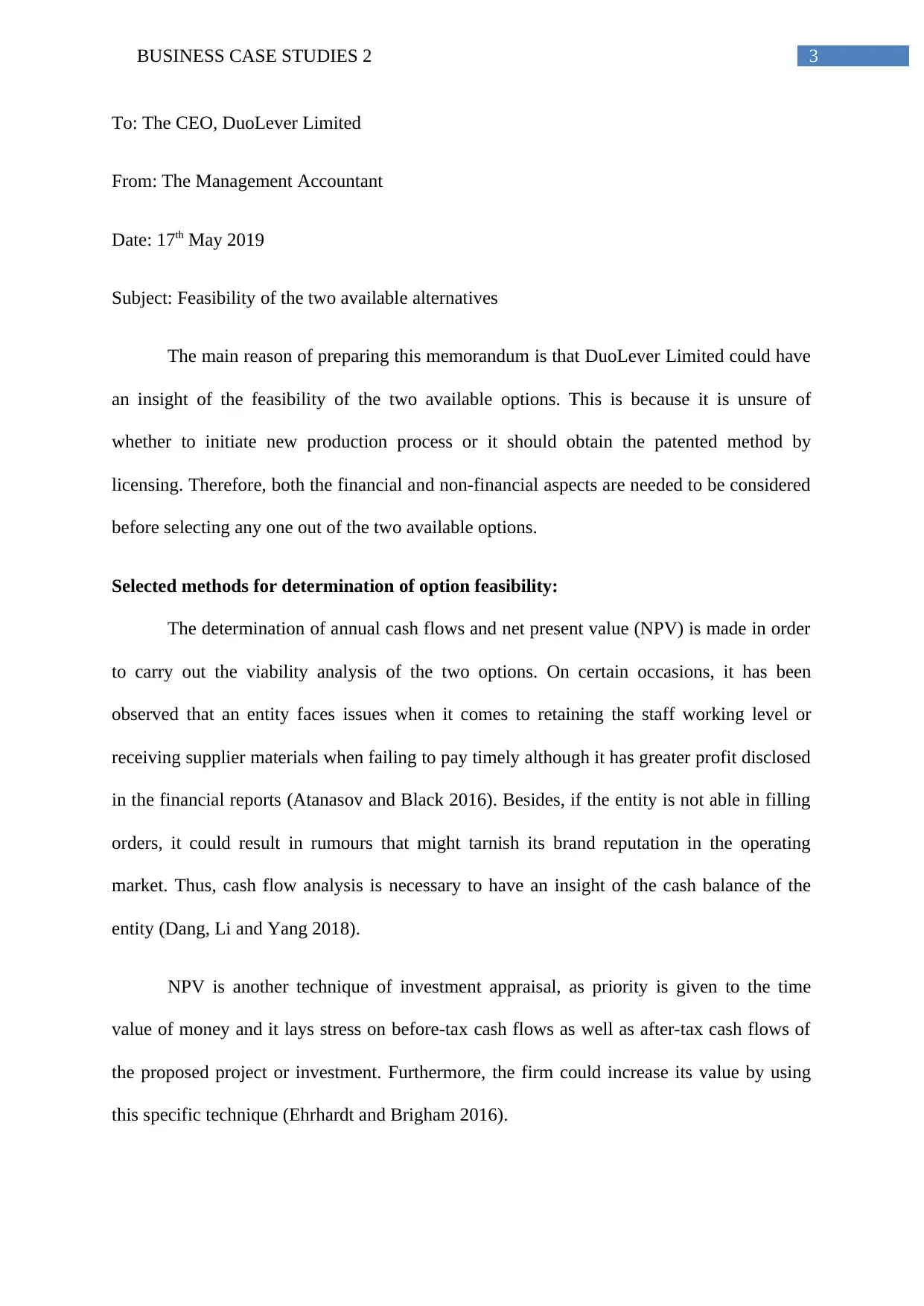
3BUSINESS CASE STUDIES 2
To: The CEO, DuoLever Limited
From: The Management Accountant
Date: 17th May 2019
Subject: Feasibility of the two available alternatives
The main reason of preparing this memorandum is that DuoLever Limited could have
an insight of the feasibility of the two available options. This is because it is unsure of
whether to initiate new production process or it should obtain the patented method by
licensing. Therefore, both the financial and non-financial aspects are needed to be considered
before selecting any one out of the two available options.
Selected methods for determination of option feasibility:
The determination of annual cash flows and net present value (NPV) is made in order
to carry out the viability analysis of the two options. On certain occasions, it has been
observed that an entity faces issues when it comes to retaining the staff working level or
receiving supplier materials when failing to pay timely although it has greater profit disclosed
in the financial reports (Atanasov and Black 2016). Besides, if the entity is not able in filling
orders, it could result in rumours that might tarnish its brand reputation in the operating
market. Thus, cash flow analysis is necessary to have an insight of the cash balance of the
entity (Dang, Li and Yang 2018).
NPV is another technique of investment appraisal, as priority is given to the time
value of money and it lays stress on before-tax cash flows as well as after-tax cash flows of
the proposed project or investment. Furthermore, the firm could increase its value by using
this specific technique (Ehrhardt and Brigham 2016).
To: The CEO, DuoLever Limited
From: The Management Accountant
Date: 17th May 2019
Subject: Feasibility of the two available alternatives
The main reason of preparing this memorandum is that DuoLever Limited could have
an insight of the feasibility of the two available options. This is because it is unsure of
whether to initiate new production process or it should obtain the patented method by
licensing. Therefore, both the financial and non-financial aspects are needed to be considered
before selecting any one out of the two available options.
Selected methods for determination of option feasibility:
The determination of annual cash flows and net present value (NPV) is made in order
to carry out the viability analysis of the two options. On certain occasions, it has been
observed that an entity faces issues when it comes to retaining the staff working level or
receiving supplier materials when failing to pay timely although it has greater profit disclosed
in the financial reports (Atanasov and Black 2016). Besides, if the entity is not able in filling
orders, it could result in rumours that might tarnish its brand reputation in the operating
market. Thus, cash flow analysis is necessary to have an insight of the cash balance of the
entity (Dang, Li and Yang 2018).
NPV is another technique of investment appraisal, as priority is given to the time
value of money and it lays stress on before-tax cash flows as well as after-tax cash flows of
the proposed project or investment. Furthermore, the firm could increase its value by using
this specific technique (Ehrhardt and Brigham 2016).
Paraphrase This Document
Need a fresh take? Get an instant paraphrase of this document with our AI Paraphraser
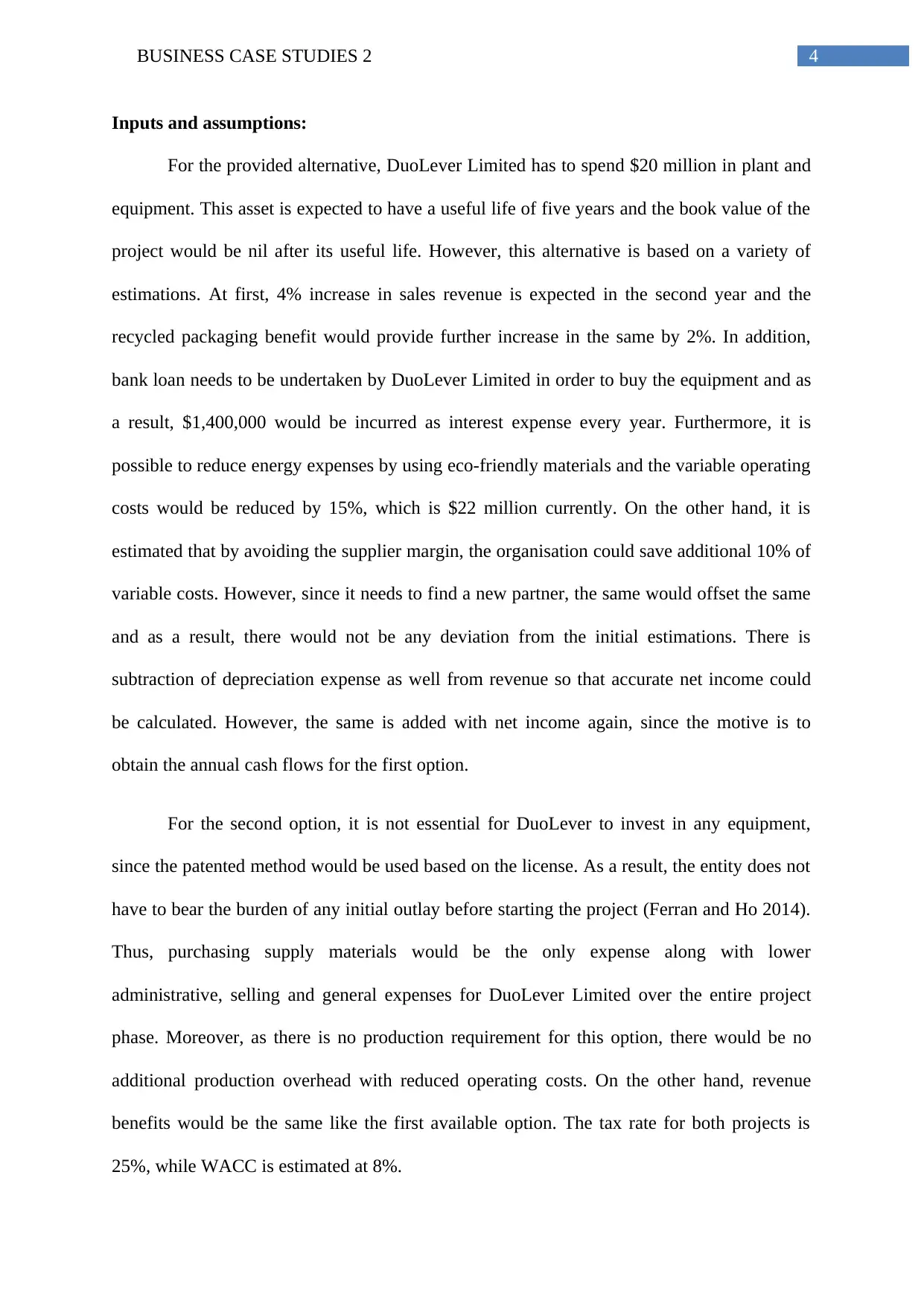
4BUSINESS CASE STUDIES 2
Inputs and assumptions:
For the provided alternative, DuoLever Limited has to spend $20 million in plant and
equipment. This asset is expected to have a useful life of five years and the book value of the
project would be nil after its useful life. However, this alternative is based on a variety of
estimations. At first, 4% increase in sales revenue is expected in the second year and the
recycled packaging benefit would provide further increase in the same by 2%. In addition,
bank loan needs to be undertaken by DuoLever Limited in order to buy the equipment and as
a result, $1,400,000 would be incurred as interest expense every year. Furthermore, it is
possible to reduce energy expenses by using eco-friendly materials and the variable operating
costs would be reduced by 15%, which is $22 million currently. On the other hand, it is
estimated that by avoiding the supplier margin, the organisation could save additional 10% of
variable costs. However, since it needs to find a new partner, the same would offset the same
and as a result, there would not be any deviation from the initial estimations. There is
subtraction of depreciation expense as well from revenue so that accurate net income could
be calculated. However, the same is added with net income again, since the motive is to
obtain the annual cash flows for the first option.
For the second option, it is not essential for DuoLever to invest in any equipment,
since the patented method would be used based on the license. As a result, the entity does not
have to bear the burden of any initial outlay before starting the project (Ferran and Ho 2014).
Thus, purchasing supply materials would be the only expense along with lower
administrative, selling and general expenses for DuoLever Limited over the entire project
phase. Moreover, as there is no production requirement for this option, there would be no
additional production overhead with reduced operating costs. On the other hand, revenue
benefits would be the same like the first available option. The tax rate for both projects is
25%, while WACC is estimated at 8%.
Inputs and assumptions:
For the provided alternative, DuoLever Limited has to spend $20 million in plant and
equipment. This asset is expected to have a useful life of five years and the book value of the
project would be nil after its useful life. However, this alternative is based on a variety of
estimations. At first, 4% increase in sales revenue is expected in the second year and the
recycled packaging benefit would provide further increase in the same by 2%. In addition,
bank loan needs to be undertaken by DuoLever Limited in order to buy the equipment and as
a result, $1,400,000 would be incurred as interest expense every year. Furthermore, it is
possible to reduce energy expenses by using eco-friendly materials and the variable operating
costs would be reduced by 15%, which is $22 million currently. On the other hand, it is
estimated that by avoiding the supplier margin, the organisation could save additional 10% of
variable costs. However, since it needs to find a new partner, the same would offset the same
and as a result, there would not be any deviation from the initial estimations. There is
subtraction of depreciation expense as well from revenue so that accurate net income could
be calculated. However, the same is added with net income again, since the motive is to
obtain the annual cash flows for the first option.
For the second option, it is not essential for DuoLever to invest in any equipment,
since the patented method would be used based on the license. As a result, the entity does not
have to bear the burden of any initial outlay before starting the project (Ferran and Ho 2014).
Thus, purchasing supply materials would be the only expense along with lower
administrative, selling and general expenses for DuoLever Limited over the entire project
phase. Moreover, as there is no production requirement for this option, there would be no
additional production overhead with reduced operating costs. On the other hand, revenue
benefits would be the same like the first available option. The tax rate for both projects is
25%, while WACC is estimated at 8%.
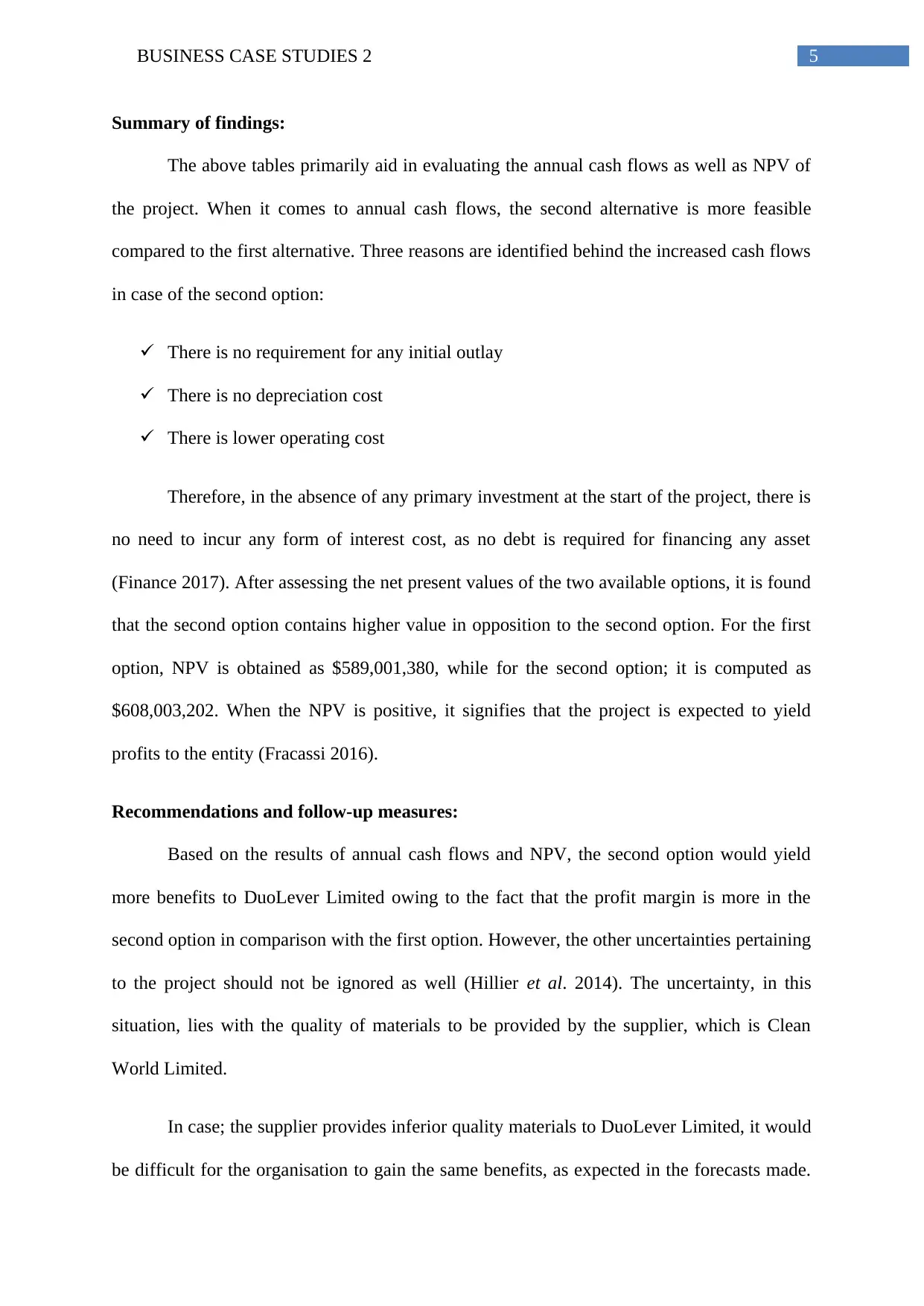
5BUSINESS CASE STUDIES 2
Summary of findings:
The above tables primarily aid in evaluating the annual cash flows as well as NPV of
the project. When it comes to annual cash flows, the second alternative is more feasible
compared to the first alternative. Three reasons are identified behind the increased cash flows
in case of the second option:
There is no requirement for any initial outlay
There is no depreciation cost
There is lower operating cost
Therefore, in the absence of any primary investment at the start of the project, there is
no need to incur any form of interest cost, as no debt is required for financing any asset
(Finance 2017). After assessing the net present values of the two available options, it is found
that the second option contains higher value in opposition to the second option. For the first
option, NPV is obtained as $589,001,380, while for the second option; it is computed as
$608,003,202. When the NPV is positive, it signifies that the project is expected to yield
profits to the entity (Fracassi 2016).
Recommendations and follow-up measures:
Based on the results of annual cash flows and NPV, the second option would yield
more benefits to DuoLever Limited owing to the fact that the profit margin is more in the
second option in comparison with the first option. However, the other uncertainties pertaining
to the project should not be ignored as well (Hillier et al. 2014). The uncertainty, in this
situation, lies with the quality of materials to be provided by the supplier, which is Clean
World Limited.
In case; the supplier provides inferior quality materials to DuoLever Limited, it would
be difficult for the organisation to gain the same benefits, as expected in the forecasts made.
Summary of findings:
The above tables primarily aid in evaluating the annual cash flows as well as NPV of
the project. When it comes to annual cash flows, the second alternative is more feasible
compared to the first alternative. Three reasons are identified behind the increased cash flows
in case of the second option:
There is no requirement for any initial outlay
There is no depreciation cost
There is lower operating cost
Therefore, in the absence of any primary investment at the start of the project, there is
no need to incur any form of interest cost, as no debt is required for financing any asset
(Finance 2017). After assessing the net present values of the two available options, it is found
that the second option contains higher value in opposition to the second option. For the first
option, NPV is obtained as $589,001,380, while for the second option; it is computed as
$608,003,202. When the NPV is positive, it signifies that the project is expected to yield
profits to the entity (Fracassi 2016).
Recommendations and follow-up measures:
Based on the results of annual cash flows and NPV, the second option would yield
more benefits to DuoLever Limited owing to the fact that the profit margin is more in the
second option in comparison with the first option. However, the other uncertainties pertaining
to the project should not be ignored as well (Hillier et al. 2014). The uncertainty, in this
situation, lies with the quality of materials to be provided by the supplier, which is Clean
World Limited.
In case; the supplier provides inferior quality materials to DuoLever Limited, it would
be difficult for the organisation to gain the same benefits, as expected in the forecasts made.
⊘ This is a preview!⊘
Do you want full access?
Subscribe today to unlock all pages.

Trusted by 1+ million students worldwide
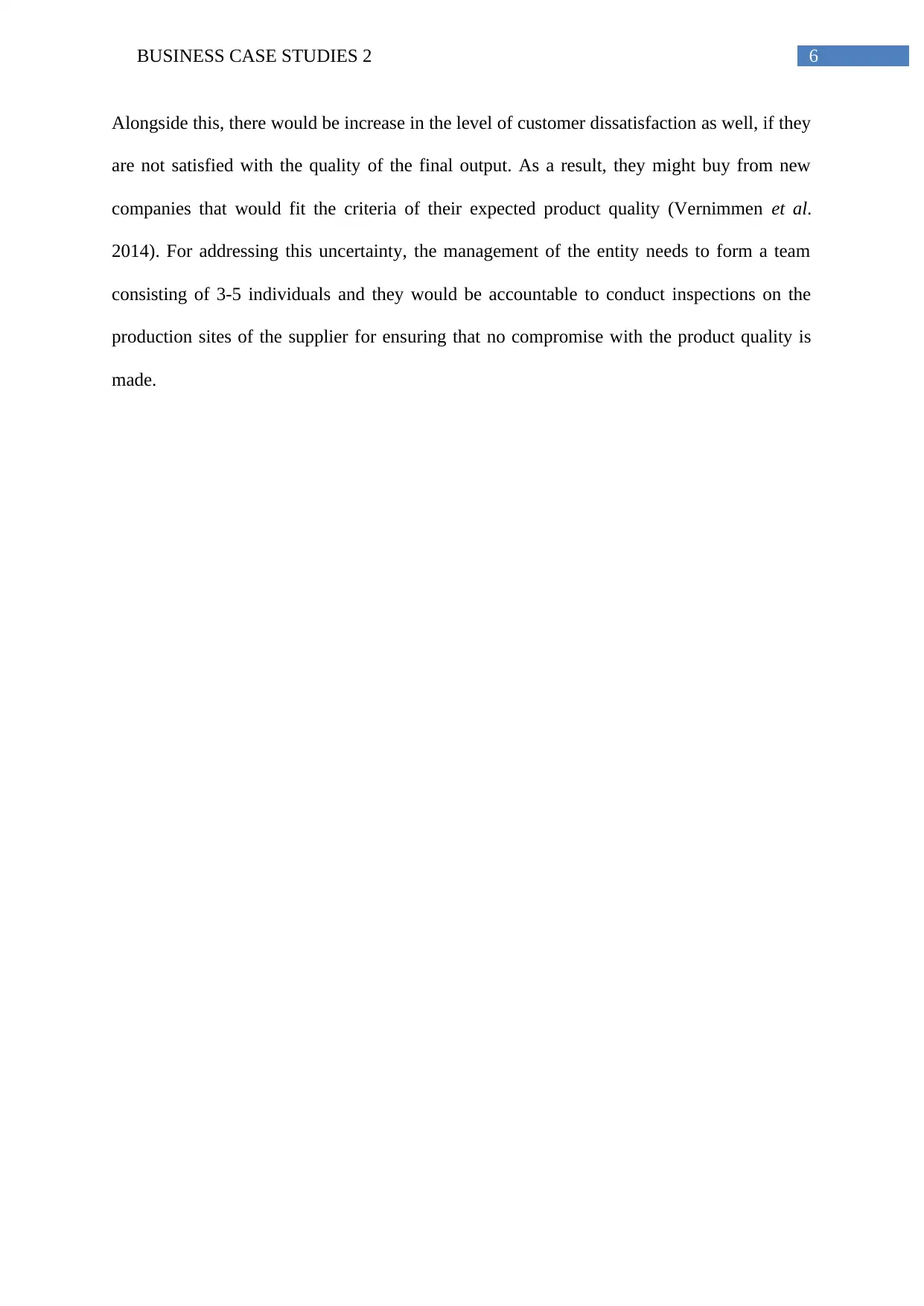
6BUSINESS CASE STUDIES 2
Alongside this, there would be increase in the level of customer dissatisfaction as well, if they
are not satisfied with the quality of the final output. As a result, they might buy from new
companies that would fit the criteria of their expected product quality (Vernimmen et al.
2014). For addressing this uncertainty, the management of the entity needs to form a team
consisting of 3-5 individuals and they would be accountable to conduct inspections on the
production sites of the supplier for ensuring that no compromise with the product quality is
made.
Alongside this, there would be increase in the level of customer dissatisfaction as well, if they
are not satisfied with the quality of the final output. As a result, they might buy from new
companies that would fit the criteria of their expected product quality (Vernimmen et al.
2014). For addressing this uncertainty, the management of the entity needs to form a team
consisting of 3-5 individuals and they would be accountable to conduct inspections on the
production sites of the supplier for ensuring that no compromise with the product quality is
made.
Paraphrase This Document
Need a fresh take? Get an instant paraphrase of this document with our AI Paraphraser
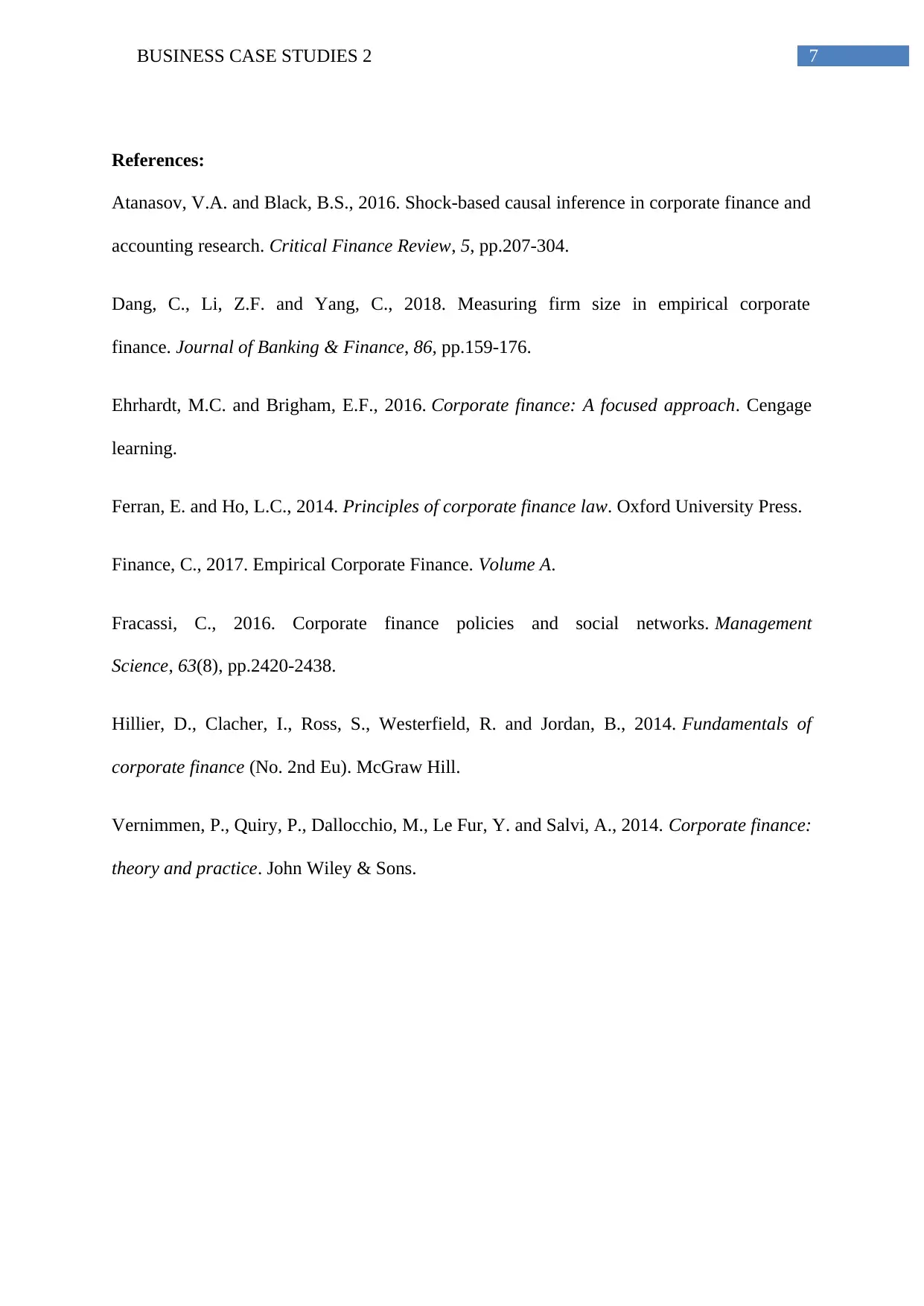
7BUSINESS CASE STUDIES 2
References:
Atanasov, V.A. and Black, B.S., 2016. Shock-based causal inference in corporate finance and
accounting research. Critical Finance Review, 5, pp.207-304.
Dang, C., Li, Z.F. and Yang, C., 2018. Measuring firm size in empirical corporate
finance. Journal of Banking & Finance, 86, pp.159-176.
Ehrhardt, M.C. and Brigham, E.F., 2016. Corporate finance: A focused approach. Cengage
learning.
Ferran, E. and Ho, L.C., 2014. Principles of corporate finance law. Oxford University Press.
Finance, C., 2017. Empirical Corporate Finance. Volume A.
Fracassi, C., 2016. Corporate finance policies and social networks. Management
Science, 63(8), pp.2420-2438.
Hillier, D., Clacher, I., Ross, S., Westerfield, R. and Jordan, B., 2014. Fundamentals of
corporate finance (No. 2nd Eu). McGraw Hill.
Vernimmen, P., Quiry, P., Dallocchio, M., Le Fur, Y. and Salvi, A., 2014. Corporate finance:
theory and practice. John Wiley & Sons.
References:
Atanasov, V.A. and Black, B.S., 2016. Shock-based causal inference in corporate finance and
accounting research. Critical Finance Review, 5, pp.207-304.
Dang, C., Li, Z.F. and Yang, C., 2018. Measuring firm size in empirical corporate
finance. Journal of Banking & Finance, 86, pp.159-176.
Ehrhardt, M.C. and Brigham, E.F., 2016. Corporate finance: A focused approach. Cengage
learning.
Ferran, E. and Ho, L.C., 2014. Principles of corporate finance law. Oxford University Press.
Finance, C., 2017. Empirical Corporate Finance. Volume A.
Fracassi, C., 2016. Corporate finance policies and social networks. Management
Science, 63(8), pp.2420-2438.
Hillier, D., Clacher, I., Ross, S., Westerfield, R. and Jordan, B., 2014. Fundamentals of
corporate finance (No. 2nd Eu). McGraw Hill.
Vernimmen, P., Quiry, P., Dallocchio, M., Le Fur, Y. and Salvi, A., 2014. Corporate finance:
theory and practice. John Wiley & Sons.
1 out of 8
Related Documents
Your All-in-One AI-Powered Toolkit for Academic Success.
+13062052269
info@desklib.com
Available 24*7 on WhatsApp / Email
![[object Object]](/_next/static/media/star-bottom.7253800d.svg)
Unlock your academic potential
Copyright © 2020–2025 A2Z Services. All Rights Reserved. Developed and managed by ZUCOL.





